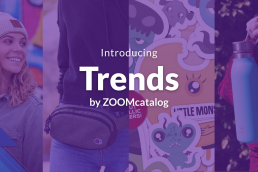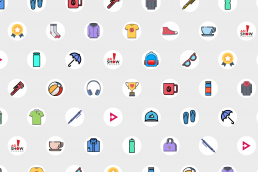The Complete Guide to Digital Catalogs
The digital world is growing. As a promotional products supplier, you’ve probably watched as the industry has shifted its focus to creating better digital experiences for distributors and end-buyers.
The last decade has brought with it a wave of new marketing tactics that go beyond the printed pages of a promotional catalog. Email, social media, and content marketing are the new mediums that distributors and their customers are working within every day, and providing a catalog that can play in all those areas is essential to finding success in today’s promotional products game.
You’ve made your way to this guide because you’re a supplier who wants to get their feet wet in the digital waters. As a team of digital creators who love to empower suppliers like you, we’ve decided to break down everything you need to know about delivering a new, elevated catalog experience.
This is your Complete Guide to Going Digital in the Promotional Products Industry.
Why should I go digital with my promotional product catalog?
The choice isn’t an easy one for many businesses, especially if you’ve been printing your catalog for a while now. What you probably haven’t considered are the trade-offs you’re making by focusing on paper catalogs alone. That’s why it’s important to understand how digital can benefit your business.
Align with end-buyers.
You’re stepping further away from end-buyers who drive demand if the only option you provide is a printed catalog. Not only are millennial buyers conducting a majority of their purchases online but so are your distributors. As the demographic of distributors and end-buyers continue to shift over the next decade, paperless communication will only become more common.
By creating a digital catalog, you inject yourself into the conversation of young buyers and can continue to meet them where they are rather than asking them to come to you.
Distribution beyond the mailbox.
Mailing catalogs is expensive and the reach is limited. Those who go digital can share their catalogs via social media, email, blogs, websites, and more.
We like to call this CODE—Create Once Distribute Everywhere. Rather than having to create double the amount of assets, you use your one catalog for all your marketing across multiple platforms.
Empower distributors.
Like we just mentioned, a digital catalog can be repurposed for other marketing efforts as well as to leverage dynamic content. Distributors and end-buyers expect more from a catalog experience than print can give them. By offering dynamic content, your distributors can tailor the catalog experience to each end-user.
Similarly, digital catalogs can constantly be updated with new products based on inventory or season. Rather than waiting for your next bi-annual catalog to print for the spring/summer, your distributors can keep fresh new products in front of end-buyers hungry for creative solutions to their promotional needs.
Keep it simple.
Searching products on a website can feel overwhelming when you have 4 different tabs and 3 browsers open. You have little control over where the user goes and what they’re considering. A digital catalog simplifies the user experience by purposefully progressing someone through your products. You get the curated catalog experience with the distribution flexibility and analytics of a website.
Digital seems like a good option, but how does it compare to print?
Like any solid business person, we know how important it is to do some thoughtful comparison. Even we have a tough time choosing between Dairy Queen and Baskin Robbins, so we can imagine this decision is a tough one. That’s why we wanted to make it easy on you and talk about all the benefits of both print and digital catalogs.
Check out this chart for a basic comparison or head over to our full article that dives deep into the differences between the two.
| Digital | |
| Static — cannot update pricing or products | Flexible – can easily update pricing and products. |
| Expensive to print | Inexpensive to create |
| Shipping charges | No distribution charges |
| Track shipping | Track opens, usage, distribution |
| Limited distribution — USPS/FedEx | Infinite distribution — email, social media, website, content, etc. |
| Limited accessibility — must be on hand | Unlimited accessibility — can access 24/7, on any device |
| More images = More pages = more cost | Include more imagery without incurring additional costs |
| Limited content | Dynamic content such as video |
| Not customizable | Unlimited customization – easily add distributor logo/contact info |
Now that you know a little bit more about the differences between the two, let’s talk about how to design your next digital catalog.
How do I design my promotional product catalog for digital?
This isn’t your grandmother’s catalog. It’s important to understand what works and what doesn’t so you can get the full benefit of going digital.
Drop the stock photography and start showing lifestyle.
This is 2020, and everyone is tired of seeing standard product shots–buyers are looking for something more. Lifestyle and environmental photography give the buyer a better look at the product in action, allowing them to see for themselves what it might look like in front of them.
Suppliers who are finding success are executing more of a “look book” that thrives on the feeling of a retail experience rather than that of a catalog experience—think about shopping at Gucci vs reading the catalog, quite different, right?
Cut the words.
We can’t reiterate it enough— keep it simple. This means reducing the amount of text on each product and leveraging bigger and more clear typefaces. Nobody wants to read an entire novel in a catalog. Make it easy for people to find what they’re looking for by reducing the amount of text per page.
Also, consider creating a style guide that will limit your design team to 3 typefaces/fonts for Headlines, subheads, and body copy.
Keep your designs clean.
Keep your catalog pages simple and uncluttered – whether it be product images, descriptions or pricing, make sure that the information is easy to read and digest.
It is important to remember that distributors want to share your catalog with their customers. This means carefully considering how your pricing is communicated, avoiding industry-specific terms such as EQP, and keeping your brand elements to a minimum. By doing so, distributors will be more inclined to customize and share your catalog as their own
Be mobile-friendly.
You’re doing something horribly wrong if you’re going digital and not creating everything for desktop and mobile. In case you didn’t know, 52.2% of all website traffic in the world was from mobile devices—which means you’re missing out if you’re not mobile-friendly.
Don’t make the mistake of only executing on one front, make sure that your entire digital experience is strong across all devices and platforms.
Use “Breakout catalogs”.
This term might be new to you, but it’s definitely worth trying. Breakout catalogs highlight a collection of specific products that one of your target audiences might find valuable. Instead of showcasing all of your products, you deliver on a particular grouping of products that are related to a season, subject, or application.
These are the main elements for crafting an effective and engaging digital catalog, which we cover more at length in our article about the best practices for 2020, for those who are looking to dig their hands deeper into digital design.
What are some examples of Breakout catalogs?
Breakout catalogs can prove to be a major addition to your marketing arsenal if you use them correctly. That being said, there are plenty of different types of digital Breakout catalogs that you can use to empower distributors to deliver more targeted products for their customers.
We’ve pulled together the ones that we find to be the most effective:
- Seasonal
- These catalogs are based on a variety of seasons from the weather to sports, the seasonal catalog covers everything a customer might want for a specific time of year.
- Check out this catalog from Augusta Sportswear who crush the fall seasonal catalog.
- Vertical Markets
- Vertical Market catalogs focus on a specific industry–hence why we use the term vertical.
- Here the focus is much more tailored to the needs of a particular industry such as real estate, construction, or education.
- Category Specific
- The purpose of this catalog is to give distributors and customers the most variety of the same types of products.
- Just think about drinkware alone. From stainless steel to water bottles, coffee mugs to whiskey tumblers, there are thousands of ways to slurp your favorite beverage, which means thousands of products to choose from.
- Here’s another example of an apparel supplier who started selling personal protective wear in the wake of COVID.
- Themes
- These catalogs are hyperfocused on one type of theme and all the products associated with it. Think back to school, trending products, or work from home catalogs.
- Here is an example of one from PCNA.
- Events
- It’s obvious, but every event needs promotional products—that’s where event catalogs come in. From the 4th of July to the start of the football season, you can create catalogs for any kind of event.
- Price Point
- This is another underrated and popular catalog that we find to be effective. The focus here is keeping it tailored to a particular price point such as $1 items or $100 items.
Now that we’ve covered all the important parts, its time to answer that question that’s been swirling in your brain like a hungry vulture.
What is the ROI of moving my promotional product catalog to digital?
The ROI of going digital is pretty simple—data. You were probably looking for a number as a response, but what often gets overlooked is the value of this data. Don’t worry, there’s plenty of green to go around as well, but data is the real MVP here.
Just like every business uses data to make the next best decision, so should you as a supplier. At the end of the day, you want to provide your customer’s customers with the best possible products that bring value—data can help you do that.
By publishing a digital catalog you glean insights into how your catalog performs in front of distributors and end-buyers. You can view access dates, total page visitors, visitor sources, and a wealth of behavioral data.
From there, you can use your digital catalog and its assets to target your potential customer more directly based on the insights you’ve gained from that data collection. Now, instead of sending your supplier catalog to every distributor, you can hyper-target distributors in the midwest who focus on sports teams and venues, if that was your target buyer.
This is where you as a supplier can start targeting your potential customers more specifically. Rather than trying to sell to every distributor, you can use your data and insights to inform your next marketing decision and find the distributors who are craving the products you sell.
Are you still wondering how you can drop the printing payments and start slinging a digital catalog that will have distributors begging to sell your products?
We at ZOOMcatalog know a thing or two about digital catalogs. We help suppliers like you craft promotional product catalogs and marketing materials that drive revenue and growth.
We’ll help you increase exposure, enhance your website, improve your marketing, and empower your distributors through digital catalog technologies that are simple to use.
Contact us to review your digital strategy with one of our consultants.
How The Coronavirus Will Shape Buyer Behavior – 3 Predictions
Let’s take a step back and look at how the coronavirus will influence businesses and consumers.
How Dunkin’ Donuts, MAGA Hats, and Marathon Runners Are Driving Promotional Product Sales
I trained for over a year, fought through injuries, and suffered for 4 hours to finish my first marathon. What am I looking for after I…
Introducing Trends by ZOOMcatalog
Each month we’re going to make sure you have all the best industry information to keep your team up to date, and your bottom line……
ZOOMcatalog attends the 2019 PPAI North American Leadership Conference and Tech Summit in Dallas
Noleen and Bryony Zasman, co-founders of ZOOMcatalog, attended the PPAI NALC and Tech Summit in Dallas.
ASI Chicago 2019 – Stand Out Products
Following the ZOOMcatalog teams visit to ASI Chicago 2019, Find out about the newest and stand out products from some of your favourite…
PPAI 2019 Women’s Leadership Conference
ZOOMcatalog co-founders Donna Lomazini and Noleen Zasman were privileged to attend the 2019 PPAI Women's Leadership Conference in New…






